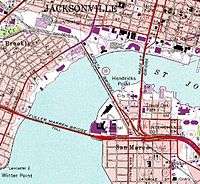Acosta Bridge
| Acosta Bridge (new) | |
|---|---|
|
| |
| Coordinates | 30°19′17″N 81°39′50″W / 30.3214°N 81.6640°WCoordinates: 30°19′17″N 81°39′50″W / 30.3214°N 81.6640°W |
| Carries |
6 lanes of 2 monorail tracks 2 sidewalks |
| Crosses | St. Johns River |
| Locale | Jacksonville, Florida |
| Official name | St. Elmo W. Acosta Bridge |
| Maintained by | Florida Department of Transportation |
| ID number |
720570 southbound 720571 northbound |
| Characteristics | |
| Design | continuous prestressed concrete segmental box girder bridge |
| Total length | 1,645 feet (501 m)[1] |
| Width | 151.3 feet (46.1 m)[1] |
| Longest span | 630 feet (190 m) |
| Clearance below | 81 feet (25 m)[1] |
| History | |
| Construction begin | 1990[1] |
| Opened | August 1994[1] |
| Acosta Bridge (old) | |
|---|---|
.jpg) The center span of the old Acosta Bridge in 1987 with the FEC Strauss Trunnion Bascule Bridge immediately behind and the old Fuller Warren Bridge in the distance. | |
| Carries |
3 lanes of |
| Crosses | St. Johns River |
| Locale | Jacksonville, Florida |
| Official name | St. Elmo W. Acosta Bridge |
| Other name(s) | The Yellow Monster |
| Maintained by | Florida Department of Transportation |
| Characteristics | |
| Design | steel vertical lift bridge |
| Total length | 1,645 feet (501 m) |
| Width | 75 feet (23 m) |
| History | |
| Opened | 1921 |
| Closed | 1991 |

The St. Elmo W. Acosta Bridge Bridge spans the St. Johns River in Jacksonville, Florida on a fixed span. It was named for City Councilman St. Elmo W. Acosta, who convinced voters to approve a $950,000 bond issue for the original bridge. It carries SR 13 (six lanes) with the two-track Jacksonville Skyway in the median. Prior to its replacement in 1991, the bridge, originally called St. Johns River Bridge, opened in 1921 and carried three lanes (center one reversible) on a lift bridge of similar design to the Main Street Bridge but was known as the Yellow Monster, largely for its tendency to stick in the upward position. Tolls were charged until 1940, earning more than $4 million for the City of Jacksonville. At some time in 1991, the original bridge was closed to allow construction of the new one to proceed.

Despite being a freeway, bicycles are permitted on the main lanes of the bridge.
The Acosta Bridge is also notable because of the blue neon lights that illuminate it at night. Although as of 2/11/2015, the Jacksonville Transportation Authority has announced that they'll "be off indefinitely with no return date on the books" citing a lack of funding for repairs. [2]
North (downtown) approach
The original north approach was a T-shaped viaduct, with the bridge ending at Riverside Avenue (US 17/SR 15 (Pre-1945 SR 3)). Just southwest of the Acosta Bridge, Riverside Avenue passed over the adjacent Florida East Coast Railway bridge approach.
When the bridge was rebuilt, the intersection was rebuilt as a semi-directional T interchange. Direct high-speed connections were provided between the bridge and both directions on Riverside Avenue, as well as a direct ramp from the bridge to the intersection of Broad Street and Bay Street (Riverside Avenue splits into a one-way pair of Broad Street and Jefferson Street north of the bridge).
South approach
The bridge originally emptied out on Miami Road (now Prudential Drive) just west of San Marco Boulevard, with a continuation, at least southbound, to San Marco Boulevard. SR 13 went south on San Marco Boulevard, and was later changed to go east on Miami Road.
Around 1958, a system of freeways was built in Jacksonville. This system included an eastern approach for the recently opened Fuller Warren Bridge, along with the older Acosta Bridge and Main Street Bridge, carrying traffic to the Philips Highway (U.S. Route 1 (SR 5)) and Atlantic Boulevard (US 90 (SR 10)). A new approach to the Acosta Bridge was built, splitting from the old one two blocks north of Miami Road, and passing over the intersection of Miami Road and San Marco Boulevard before merging with the other bridge approaches. The old approach became southbound only, and northbound access was provided at Mary Street, two blocks north of Miami Road. A northbound exit was also provided at Mary Street for traffic coming from the south and east. No southbound entrance was provided, but the adjacent Main Street Bridge approach provided access in that direction.
When the bridge was rebuilt, the south approach was kept almost identical. The only real difference was a new northbound onramp from Museum Circle, one block north of Mary Street. The popular Diamond Head Lobster House was in its path and had to be demolished.[3]
References
- 1 2 3 4 5 Acosta Bridge at Structurae
- ↑ http://www.firstcoastnews.com/story/news/traffic/2015/02/11/neon-blue-lights-out-on-acosta-bridge/23273557/
- ↑ Littlepage, Ron (January 20, 2013). "After 3 failures, will Jacksonville spurn more restaurant deals?". Florida Times-Union. Retrieved 21 January 2013.
External links
- List of Jacksonville Bridges both past and present
- Acosta Bridge Replacement
- Acosta Bridge license plates, allowing owners to travel over the bridge for free
- City of Jacksonville article about the bridges (PDF)